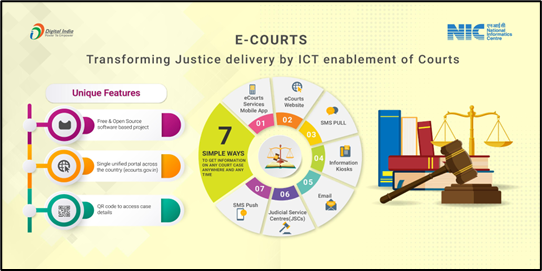Why in News?
- The Chief Justice of India (CJI) recently said that the budgetary allocation of ₹7,000 crore for the third phase of the e-courts project will ensure that courts reach every citizen.
- The Budget 2023 outlay for the third phase of the project is a mighty jump from the ₹639.411 crore and ₹1,670 crore spent in the first two phases.
What’s in Today’s Article?
- What is the e-Courts Integrated Mission Mode Project?
- What are the Major Initiatives Launched under the Project?
- What is the Role of Judiciary in a Changing World and Way Ahead?
What is the e-Courts Integrated Mission Mode Project?
- As part of the National eGovernance Plan, the Project has been under implementation (under the aegis of the e-Committee SC) since 2007 for ICT development of the Indian Judiciary.
- It is a Pan-India Project, monitored and funded by the Department of Justice, Ministry of Law and Justice for the District Courts across the country.
- It is based on the National Policy and Action Plan for Implementation of Information and Communication Technology (ICT) in the Indian Judiciary-2005.
- The Project envisages:
- To provide efficient and time-bound citizen centric services delivery.
- To develop, install and implement decision support systems in courts.
- To automate the processes to provide transparency in accessibility of information.
- To enhance judicial productivity, to make the justice delivery system affordable, accessible, cost effective, predictable, reliable and transparent.
- The Phase I of e-Courts was concluded in 2015 in which 14,249 Court sites were computerised. Under Phase II, 18,735 District and Subordinate courts have been computerised so far.

What are the Major Initiatives Launched under the Project?
- Case Information Software (CIS) based on customised Free and Open-Source Software (FOSS) has been developed.
- National Judicial Data Grid (NJDG) is a flagship project launched in 2015 for monitoring pendency and disposal of the cases in HCs and Subordinate Courts.
- Virtual Courts (as of July 2022, there are 20 Virtual Courts in 16 States/UTs) and using Video Conferencing.
- An e-Filing system has been rolled out for the electronic filing of legal papers with advanced features like online submission of Vakalatnama, eSigning, online video recording of oath, etc.
- eSewa Kendras: To make justice delivery inclusive and to mitigate handicaps caused by digital divide, eSewa Kendras have been rolled out to provide e-filing services to lawyers and litigants.
- National Service and Tracking of Electronic Processes (NSTEP) has been developed for technology enabled process serving and issuing of summons. It has currently been implemented in 28 HCs.
- Secure, Scalable & Sugamya Website as a Service (S3WAAS) Website: A new divyang friendly website in 13 regional languages to enable them to access the information using assistive technologies.
- IEC and Training: As part of the IEC campaign several initiatives have been taken to educate the Judicial Officers, lawyers and public about the facilities available.
What is the Role of Judiciary in a Changing World and Way Ahead?
- The CJI at an event organised to commemorate the 73rd anniversary of the SC, said that the inflow of cases to the SC has increased multi-fold since its establishment on January 28, 1950.
- In fact, 12,471 cases were disposed of in the last two months alone and the apex court had heard 3.37 lakh cases between March 23, 2020 and October 30, 2022.
- The court has also emerged over the years as a strong proponent of gender justice and human rights.
- There is the need for judges to not let their personal opinions overshadow facts. Such a scenario would result in the destruction of trust in the impartiality of the judiciary.
- The judiciary should work hard to strengthen its very foundation - public confidence.
- The judges should expand their knowledge base, become aware and sensitive of developments in other jurisprudence and be open to learning as disputes may tend to get more and more complex and interlinked.
- Aloofness of the judiciary from the general public should not prevent judges from engaging with citizens to make them aware of the judicial work being done.










